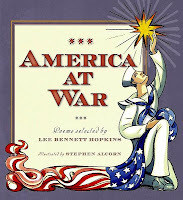The Way a Door Closes
Smith, Hope Anita. 2003. THE WAY A DOOR CLOSES. Ill. by Shane W. Evans. New York: Henry Holt and Company. ISBN 978-0-8050-6477-3
Review:
THE WAY A DOOR CLOSES tells the story of thirteen-year-old C.J. and his family through a series of 34 poems. The first eight poems describe a happy, contented African American family. It is with the ninth poem, "Close Your Eyes" that we see the first hint of trouble. C.J.'s family falls on hard times when his father loses his job. In "The Way a Door Closes", C.J. knows his father has left the family, though he tries to keep the faith that his father will someday return. The next nineteen poems reveal the roller coaster of emotions one feels at the loss of a loved one. Finally, with "Prodigal Son", C.J.'s father returns. Since C.J.'s father is introduced to us as a kind, loving husband and father, it is a pleasant experience to end the story with "Astronomy 101" where "He can't find enough words/ to say how sorry he is./ But he keeps on./ Each word rooting him to us/ like a tree/ that's planted by the water and/ he shall not be moved."
Smith's poems are complemented by the illustrations of Shane W. Evans. Evans' illustrations in muted greens, browns, blues, and golds perfectly capture the mood of each poem.
Winner of the Coretta Scott King Award, THE WAY A DOOR CLOSES accurately portrays a loving African American family that journeys through the heartbreak anger, and fear that accompanies a family crisis such as the loss of a job.
Highlighted Poem:
Grandmomma's China Bowl by Hope Anita Smith
Grandmomma's china bowl
sits
with its hands cupped
but open.
Always begging for more.
More mints.
More nuts.
More
of whatever is being offered.
And with each offering
it extends an invitation to
hands.
Never fearing
"empty" or
"gone."
Possible Uses:
Though "Grandmomma's China Bowl" may seem less emotionally packed than other poems in this book, it offers many lessons.
Teachers could use this poem to begin a lesson on personification.
Teachers could also use this poem to discuss C.J.'s feelings of "empty" and "gone".
I'm sure if students thought about it, they would find objects in their own homes that give them a sense of comfort just as the china bowl does for C.J.

